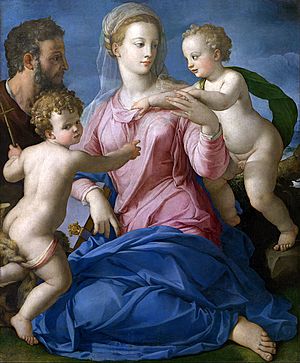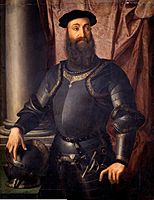Bronzino facts for kids
Quick facts for kids
Bronzino
|
|
|---|---|

Portrait of Bronzino by Alessandro Allori (detail)
|
|
| Born |
Agnolo di Cosimo
17 November 1503 Florence, Republic of Florence
|
| Died | November 23, 1572 (aged 69) Florence, Duchy of Florence
|
| Nationality | Italian |
| Known for | Painting |
| Movement | Mannerism |
| Signature | |
 |
|
Agnolo di Cosimo (born November 17, 1503 – died November 23, 1572), usually known as Bronzino, was a famous Italian painter from Florence. His nickname, Bronzino, might have come from his slightly dark skin or reddish hair.
Bronzino lived his whole life in Florence. From his late 30s, he worked as the official painter for Cosimo I de' Medici, Grand Duke of Tuscany. He was best known for his portraits. But he also painted many religious scenes and some allegorical (symbolic) pictures. One of his most famous works is Venus, Cupid, Folly and Time, painted around 1544–45.
Many portraits of the Medici family exist in different versions. This is because Cosimo often sent copies of his portrait as gifts to other leaders. Bronzino trained with Pontormo, who was a leading painter in Florence at the time. Pontormo greatly influenced Bronzino's style. However, Bronzino's figures always look calm and a bit serious. They don't show the strong emotions seen in his teacher's work. For a long time, people thought his art was cold or artificial. But in recent years, his paintings have become much more appreciated.
Contents
Life of Bronzino
Bronzino was born in Florence. His father was a butcher. When he was 14, Bronzino became a student of Pontormo. Pontormo had a big impact on Bronzino's painting style. They worked together for most of Pontormo's life.
An early example of Bronzino's work can be seen in the Capponi Chapel in Florence. Pontormo designed the chapel and painted the main altarpiece. Bronzino likely painted the frescoes (wall paintings) on the dome, which are now gone. He also painted two of the four round pictures of the evangelists. His style was so similar to Pontormo's that experts still debate which paintings each artist did.
Later in his life, Bronzino became an important member of the Florentine Accademia delle Arti del Disegno. This was an art academy that he helped start in 1563.
The painter Alessandro Allori was Bronzino's favorite student. Bronzino was living with the Allori family when he died in Florence in 1572. Bronzino spent almost all of his career in Florence.

Bronzino's Artworks
Portraits
Bronzino first started working for the Medici family in 1539. He helped create decorations for the wedding of Cosimo I de' Medici, Grand Duke of Tuscany to Eleonora di Toledo. Soon after, he became the official court painter for the Duke and his family. He kept this job for most of his career.
His portraits show people who look calm, elegant, and very stylish. They often seem proud and confident. These paintings influenced how court portraits were made in Europe for about a hundred years. Many of these famous paintings exist in several versions, often made by Bronzino's workshop. Besides painting the rich people of Florence, Bronzino also painted famous poets like Dante and Petrarch.
Bronzino's most famous portraits include those of the Duke and Duchess, Cosimo and Eleonora. He also painted people from their court, like Bartolomeo Panciatichi and his wife Lucrezia. These paintings, especially those of the Duchess, are known for their amazing detail. Bronzino paid close attention to her clothes, which almost seem to have a life of their own.
In the painting of the Duchess with her son Giovanni, the rich fabric of her dress takes up more space than the people themselves. Some people even thought the Duchess loved this dress so much that she was buried in it! Others wondered if the dress was even real, or if Bronzino just made it up. Either way, this painting was copied many times by Bronzino and his workshop. It became one of the most famous images of the Duchess. The version shown here is in the Uffizi Gallery in Florence.
Bronzino was also a poet. His most personal portraits are perhaps those of other writers, like his friend the poet Laura Battiferri.
Religious and Symbolic Paintings
Around 1540–41, Bronzino started working on frescoes for the Chapel of Eleanora di Toledo in the Palazzo Vecchio. He also painted an altarpiece called Deposition of Christ for the chapel. Before this, his religious paintings were less in the "Mannerist" style. They were more balanced, like earlier Renaissance art.
However, in this fresco series, his style became more elegant and classical. His religious works show the art style popular in the Florentine court during the mid-1500s. This style is often seen as very artistic and less emotional. Crossing the Red Sea is a good example of Bronzino's style at this time. The Duchess Eleanora was a strong supporter of the Jesuit religious order.
Bronzino's art often includes clever nods to earlier painters. For example, in one of his last large frescoes, The Martyrdom of St. Lawrence (1569), almost every twisted pose can be traced back to Raphael or Michelangelo. Bronzino greatly admired Michelangelo. Another major work by Bronzino is a series of tapestries about The Story of Joseph for the Palazzo Vecchio.
Many of Bronzino's paintings are still in Florence. Other examples can be found in the National Gallery, London, and other museums around the world.
Selected Works
- St. Mark (c. 1525) – Oil on Wood, Capponi Chapel, Santa Felicita, Florence
- St. Matthew (c. 1525) – Oil on Wood, Capponi Chapel, Santa Felicita, Florence
- Portrait of Lorenzo Lenzi (1527–28) – Oil on panel, castello Sforzesco, Milan
- Pietà (c. 1530) – Oil on panel, 105 x 100 cm, Uffizi, Florence
- Portrait of Dante (1530) – Oil on panel, Milan
- Portrait of a Lady in Green (1530–32) – Oil on panel, 76,7 x 65,4 cm, Royal Collection, Windsor
- St. Sebastian (c. 1533) – Oil on panel, 87 x 77 cm, Museo Thyssen-Bornemisza, Madrid
- Holy Family (1534–40) – Oil on wood, 124.5 x 99.5 cm, Kunsthistorisches Museum, Vienna
- Adoration of the Shepherds (1535–1540) – Oil on wood, 65,3 x 46,7 cm, Museum of Fine Arts, Budapest
- Portrait of Ugolino Martelli (before 1537) – Oil on panel, 102 x 85 cm, State Museums, Berlin
- Portrait of Bartolomeo Panciatichi (c. 1540) – Tempera on wood, 104 x 84 cm, Uffizi, Florence
- Holy Family (c. 1540) – Oil on wood, 117 x 93 cm, Uffizi, Florence
- Portrait of a Young Man with a Book (c. 1540) – Oil on wood, 96 x 75 cm, Metropolitan Museum of Art, New York
- Venus, Cupid, Folly and Time (Allegory; 1540–45) – Oil on panel, 146 x 116 cm, National Gallery, London
- Adoration of the Bronze Snake (1540–45) – Fresco, 320 x 385 cm, Palazzo Vecchio, Florence
- Deposition of Christ (1540–45) – Oil on panel, 268 x 173 cm, Musée des Beaux- Arts, Besançon
- Alessandro de Médici (1540–1553) – Oil on panel, 34,90 x 26,20 cm, Cerralbo Museum, Madrid.
- Crossing of the Red Sea (1541–42) – Fresco, 320 x 490 cm, Palazzo Vecchio, Florence
- Portrait of a Young Girl (1541–45) – Oil on wood, 58 x 46,5 cm, Uffizi, Florence
- Portrait of Bia de' Medici (c. 1542) – Tempera on panel, 63 x 48 cm, Uffizi, Florence
- Portrait of Cosimo I de' Medici (1545) – Oil on panel, 74 x 58 cm, Uffizi, Florence
- Portrait of Cosimo I de' Medici (c. 1545) – Oil on panel, 76,5 x 59 cm, Museo Thyssen-Bornemisza, Madrid.
- Portrait of Giovanni de' Medici as a Child (c. 1545) – Oil on wood, 58 x 46 cm, Uffizi, Florence
- Portrait of Eleanor of Toledo (c. 1545) – Oil on panel, 115 x 96 cm, Uffizi, Florence
- Portrait of Lucrezia Panciatichi (c. 1545) – Oil on panel, 101 x 82.8 cm, Uffizi, Florence
- Christ on the Cross (c. 1545) – Oil on panel, 145 x 115 cm, Musée des Beaux-Arts, Nice
- Portrait of Stefano Colonna (1546) – Oil on panel, 125 x 95 cm, Galleria Nazionale d'Arte Antica, Rome
- Portrait of Don Garcia de' Medici (1550) – Oil on panel, Museo del Prado, Madrid
- Portrait of a Lady (c. 1550) – Oil on wood, 109 x 85 cm, Galleria Sabauda, Turin
- PortraIt of a Young Man (possibly Pierino da Vinci) (c. 1550)
- Venus, Cupid and Jealousy (or Envy) (c. 1550) – Oil on wood, 192 x 142 cm, Szépművészeti Múzeum, Budapest
- Portrait of Andrea Doria as Neptune (1550–1555) – Oil on canvas, 115 x 53 cm, Pinacoteca di Brera, Milan
- St. John the Baptist (1550–1555) – Oil on wood, 120 x 92 cm, Galleria Borghese, Rome
- Portrait of Pierantonio Bandini (c. 1550–1555) – Oil on wood, 106,7 x 82,5 cm, National Gallery of Canada
- Portrait of Francesco I de' Medici (1551) – Tempera on wood, 58.5 x 41.5 cm, Uffizi, Florence
- Portrait of Maria de' Medici (1551) – Tempera on wood, 52.5 x 38 cm, Uffizi, Florence
- Portrait of Ludovico Capponi (1551) – Oil on wood, 117 x 86 cm, Frick Collection, New York
- Christ in Limbo, 1552, Florence, Museo dell'Opera di Santa Croce
- Portrait of the Dwarf Nano Morgante (1552)
- Holy Family (1555–1560) – Tempera on wood, 117 x 99 cm, Pushkin Museum, Moscow
- Portrait of Laura Battiferri (1555–1560) – Oil on canvas, 83 x 60 cm, Palazzo Vecchio, Florence
- Noli me tangere (1561) – Oil on canvas, 291 x 195 cm, Musée du Louvre, Paris
- Allegory of Happiness (1564) – Oil on copper, 40 x 30 cm, Uffizi, Florence
- Deposition of Christ (1565) – Oil on wood, 350 x 235 cm, Galleria dell'Accademia, Florence
- Martyrdom of St. Lawrence (1569) – Fresco, San Lorenzo, Florence
- Works
-
Andrea Doria as Neptune, 1550–55, Pinacoteca di Brera, Milan
-
Garcia de' Medici, Prado Museum
-
Alessandro de' Medici, Cerralbo Museum
See also
 In Spanish: Bronzino para niños
In Spanish: Bronzino para niños





















